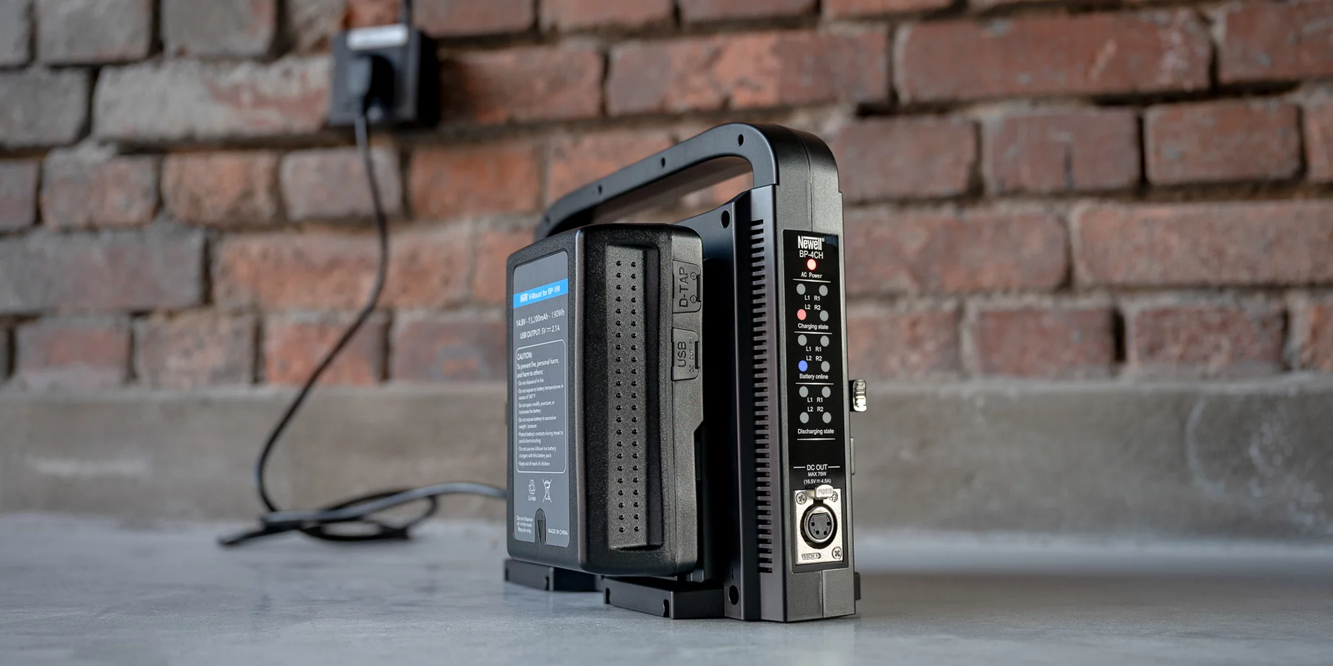V-mount batteries are a staple in professional video production, photography, and broadcasting. Known for their high capacity, durability, and versatility, they power everything from cinema cameras to LED lights and field monitors.
If you’ve spent time around film crews or on set, you may have heard someone ask: “Can you charge a V-mount battery with a D-Tap?” This is a common question, especially for those looking for flexible charging options in the field.
The short answer? Yes, you can—but there are important limitations, safety precautions, and technical details you must understand before attempting it.
In this article, we’ll explore:
- What D-Tap is and how it works
- How charging via D-Tap compares to using a dedicated V-mount charger
- Pros and cons of D-Tap charging
- Best practices for safe and efficient charging
Understanding V-Mount Batteries
Before we dive into D-Tap charging, let’s clarify what we’re dealing with.
A V-mount battery is a professional-grade rechargeable lithium-ion battery that uses a standardized “V-lock” plate system to attach securely to cameras, lights, and accessories. These batteries typically range from 95Wh to over 300Wh in capacity and deliver 14.4V nominal voltage.
They’re the go-to choice for high-power devices because:
- They last longer than consumer-grade batteries.
- They can be hot-swapped for continuous operation.
- They support multiple outputs (including D-Tap).
What is D-Tap?
D-Tap (also called P-Tap or Power Tap) is a two-pin connector found on many V-mount batteries. Originally developed by Anton Bauer, it allows you to draw power from the battery to run accessories—such as monitors, wireless transmitters, or LED lights—without using the main camera output.
D-Tap ports typically output 14–16.8 volts DC and can handle up to 10A of current (varies by manufacturer).
Can You Really Charge Through a D-Tap Port?
Yes, many modern V-mount batteries support bi-directional D-Tap ports, meaning they can both output power and receive charging power through the same port. However:
- Not all D-Tap ports are bi-directional—some are output-only.
- You must check your battery’s specifications before attempting D-Tap charging.
- Using an incompatible charger could damage the battery or cause overheating.
How D-Tap Charging Works
When you use a D-Tap charger:
- The charger outputs DC voltage (usually 16.8V) directly to the battery via the D-Tap port.
- The battery’s internal charging circuit regulates the incoming current.
- The battery charges until it reaches full voltage, then the charger stops supplying current.
This is fundamentally different from AC-powered desktop chargers, which often provide more intelligent multi-stage charging and can monitor the battery’s health.
Pros of Charging V-Mount Batteries with D-Tap
- Portability – D-Tap chargers are small, lightweight, and easy to carry in a gear bag.
- Field Charging – Perfect for on-location shoots without access to wall outlets (when paired with DC power sources like vehicle adapters).
- Cost-Effective – D-Tap chargers are often cheaper than full-size dual or quad V-mount chargers.
- Emergency Backup – If your main charger fails, a D-Tap charger can save the day.
Cons and Limitations of D-Tap Charging
- Slower Charging – Most D-Tap chargers output less current (around 2A), so charging can take longer than with a dedicated high-amp charger.
- Single Battery Only – D-Tap charging usually charges one battery at a time.
- Heat Build-Up – Charging through a small connector can cause localized heating.
- Not Universally Supported – Older batteries may not accept charging current through D-Tap.
- Less Intelligent Charging – Some D-Tap chargers lack advanced features like cell balancing or health monitoring.
How to Check if Your V-Mount Battery Supports D-Tap Charging
Before plugging in a D-Tap charger:
- Read the Manufacturer’s Manual – Look for explicit confirmation of D-Tap charging capability.
- Check the Label – Some batteries have “D-Tap Charge” printed near the port.
- Look for Specs Online – Product listings and datasheets usually clarify charging options.
- Contact Support – If unsure, ask the manufacturer directly.
⚠ Warning: If your battery’s D-Tap is output-only and you feed voltage into it, you could short the battery or permanently damage its internal electronics.
Steps to Safely Charge a V-Mount Battery with D-Tap
If your battery supports D-Tap charging, follow these steps:
- Use the Right Charger
- Voltage: Should match your battery’s charging voltage (typically 16.8V for a 4-cell Li-ion pack).
- Current: Stay within the manufacturer’s recommended range (usually 1.5A–3A).
- Connect Charger to Battery
- Align the D-Tap plug carefully with the battery port.
- Insert gently to avoid damaging the pins.
- Monitor Charging
- Keep the battery in a cool, ventilated place.
- Avoid charging unattended for long periods.
- Unplug When Full
- D-Tap chargers may not have auto-shutoff features as sophisticated as desktop chargers, so monitor the process.
When to Use D-Tap Charging vs. Dedicated Charger
| Situation | Best Choice |
| In the studio | Dual/Quad AC V-Mount charger |
| On location without AC | D-Tap charger from DC source |
| Emergency backup | D-Tap charger |
| Multiple batteries | Multi-bay V-Mount charger |
Popular D-Tap Chargers for V-Mount Batteries
Some reputable models include:
- Indipro Tools D-Tap Pro Charger – Compact, 2A output.
- Core SWX GP-DUOS D-Tap Charger – Rugged design for field use.
- SmallRig Portable D-Tap Charger – Affordable, travel-friendly option.
Pro Tips for Maximizing Battery Life
- Avoid Overheating – Heat is the enemy of lithium-ion cells.
- Don’t Deep Discharge – Try not to let voltage drop below 20%.
- Charge Regularly – Lithium-ion batteries prefer frequent top-ups over full drains.
- Store at 40–60% Charge if not in use for long periods.
Final Verdict
Charging a V-mount battery with a D-Tap is a useful, practical solution—especially for field work, travel, and emergencies. While it’s not as fast or feature-rich as a dedicated V-mount charger, it provides a lightweight, portable alternative that many professionals rely on.
The key is to ensure compatibility, use a quality charger, and follow safety best practices. With the right setup, D-Tap charging can be a lifesaver in the fast-paced world of film and photography.



